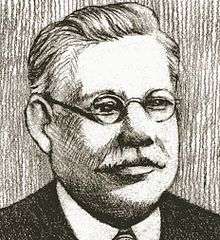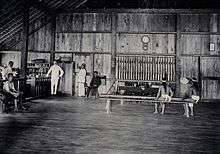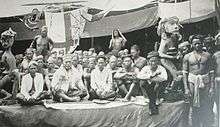Marudi, Sarawak
| Marudi | |
|---|---|
| Town | |
| Other transcription(s) | |
| • Chinese | 馬鲁帝 |
| Nickname(s): Claude Town (Brooke Administration) | |
 Marudi | |
| Coordinates: 4°11′0″N 114°19′0″E / 4.18333°N 114.31667°E | |
| Country |
|
| State |
|
| Government | |
| • District Officer |
Markus Sibong (District Officer) |
| Area | |
| • Total | 22,070.0 km2 (8,518 sq mi) |
| Population (2010[1]) | |
| • Total | 90,100 |
| Demonym(s) | Marudian |
| Time zone | MST (UTC+8) |
| • Summer (DST) | Not observed (UTC) |
| Postal code | 9805x |
| International dialling code prefix | 085 (landline only) |
| Vehicle registration plate prefix |
QM (for all vehicles except taxis) HQ (for taxis only) |
| Website | www.marudidc.org |
Marudi is a town on the Baram River in Miri Division, Sarawak, Malaysia. Marudi is a quiet town situated inland from Miri, similar in size to Kapit though nowhere near as busy. Its main attraction is another of the Brooke outposts, the beige wooden Fort House. It is the cultural heart of Sarawak's highland tribesfolk, collectively called Orang Ulu. Before Miri was founded, Marudi was the administrative centre of the northern region of Sarawak.
Marudi, a riverine town about 100 km upriver from Kuala Baram, is the largest town in the sparsely populated Baram district. It is the district administrative headquarters and has been since the days of the White Rajahs. Marudi used to be a stepping stone to the well-known tourist destination, Gunung Mulu National Park. Pioneer tourists would travel from Miri to Marudi first, and then from the river, tourists would have to use long boats cutting through few adventurous rapids upstream before reaching Mulu. With the completion of a small airport at Mulu, most tourists prefer to take Twin Otters operated by MASwings of Malaysia Airlines direct from Miri Airport.
Brooke administration




Charles Brooke succeeded James Brooke as the new Rajah of Sarawak in 1868.
By 1883, Sultan of Brunei (Sultan Abdul Momin) ceded the Baram region (including Miri) to Charles Brooke.[2][3]
The fourth division of Sarawak was immediately created with the installation of Mamerto George Gueritz as the first Resident of the Division.
A fort was built in at Marudi, 43 km to the east of Miri)[4] in 1883: it was named Claudetown in honour of Claude Champion de Crespnigy, Resident of the Third Division when he died in 1884, and became the administrative centre of the division.
The administration was helped by two junior officers, 30 rangers, and a few native police.[5]
Charles Hose became Resident of Baram District in 1891 and the fort in Marudi was renamed as "Fort Hose".
To restore peace among various ethnic tribes fighting in the Baram region, Charles Hose decided to organise a peace conference at his fort in April 1899 right after a difficult but successful journey to visit the Madangs people in interior Baram (at the foot of Mudong Alan Lata river also known as Data river(a tributary to Silat river)).
This peace conference also led to the birth of first Baram Regatta, a long boat race competition among the natives which continued to be held until today.[6]
The Resident Office moved from Marudi to Miri in 1912 after rapid oil discovery activity development in Miri.
Transportation
Air
Marudi is served by Marudi Airport (MUR) which is in the town. Twin Otters fly to Miri up to nine times daily and serve Bario, Long Banga, Long Lellang, Long Akah and Long Seridan. The airport is a 10-minute (1 km) walk east of the centre. It contains Runway 10/28 that is 1 km long and its parking bay can handles 3 to 4 de Havilland Canada DHC-6 Twin Otter at the same time.

Water
Express boats between Marudi and Kuala Baram used to operate regularly in the morning and early afternoon until the road connecting Miri to Marudi was paved. Since then there is only one boat operating and it leaves Miri early in the morning.
Taxis go from Kuala Baram to Miri.
Express boats service stop business since 1 Jun 2015.
Land
Marudi is now has a connection road to Miri which only need about 1.5 hours to reach Miri City. But there's still a ferry need to passby at Sungai Baram, Ridan. The ferry fee just reduced from RM15.00 to RM1.00 per one way after the Chief Minister of Sarawak announced at Dewan Undangan Negeri Sarawak in April 2015.
Tourism

The main tourist attraction in the town is "Fort Hose". Fort Hose was a wooden fort built during the Brooke administration. The fort was named after an ethnographer and a photographer Charles Hose. The fort was later converted into a museum which houses some ethnographic photographs, local textiles, handicrafts, and ceremonial items. The museum is accessible from Jalan Fort which is 10 minutes from the main bazaar.[7]
.jpg)

Foods in Marudi
The most famous food in Marudi is the Marudi Kueh Tiaw. It can be found in every Chinese Restaurant in Marudi Town area. Compared with other place's Kueh Tiaw in Malaysia, Marudi Kueh Tiaw tastes different, partly because it is thicker. Marudi Handmade Bread is also one of a must-try food in Marudi, it can be found in Ah Pong Cafe which just located beside Marudi Town Square. Since Marudi is a riverside-town, so you can found out that there's lots different type river fishes here. The most famous river-food in Marudi are Belidah fish (fish ball/fish cake), Tapah Fish, Tutu Fish and also the famous Bighead Prawn (udang galah). You can taste these all the river-foods at some restaurants here. If you have problems with the location, do not feel hesitate to ask the local people, they're willing to guide you because small town people are always friendly.
- Chan's Restaurant 085-755417
Marudi government departments / emergency call
- District Office 085-755211, 755770
- Marudi District Council 085-755755
- Police Station 085-755221, 755222, 755751
- Marudi Hospital 085-755511 (24-hour hotline)
- Fire Station 085-755189
- Sesco (power station) 085-755231
Banks
- Public Bank (with ATM accepted VISA, MASTER and so on)
- RHB Bank/finance (with ATM)
- Bank Rakyat/finance (ATM only that accepted VISA, MASTER and so on)
- Bank Simpanan Nasional (with ATM accepted VISA, MASTER and so on)
Education
Kindergarten
- Marudi Methodist
- Yuk Ying
Primary school
- SJK Chung Hua Primary School
- SJK Sungai Jaong Primary School
- SRB Qiao Nang Primary School
- SRB Hua Nang Primary School
- Good Shepherd Primary School
- Dato Sharif Hamid Primary School
Secondary school
- SMK Telang Usan
- SMK Marudi
College and technic school
- Technic College (vehicle)
See also
| Wikimedia Commons has media related to Marudi, Sarawak. |
References
- ↑ "Basic Population Characteristics by Administrative Districts, published by the Department of Statistics, Malaysia" (PDF). Retrieved 26 July 2011.
- ↑ "Chronology of Sarawak throughout the Brooke Era to Malaysia Day". The Borneo Post. 16 September 2011. Archived from the original on 6 February 2015. Retrieved 24 March 2015.
- ↑ "Laman Web Rasmi Pejabat Residen dan Daerah di Miri - Sejarah Miri (Official Website of Miri Resident and District Office - History of Miri)" (in Malay). Miri Resident and District Office. Retrieved 24 March 2015.
- ↑ Joseph, Anthony (28 May 2012). "Road upgrade will reduce Miri—Marudi travelling time". The Borneo Post. Archived from the original on 26 March 2015. Retrieved 26 March 2015.
- ↑ Hose, Charles; McDougall, William (1912). The pagan tribes of Borneo; a description of their physical, moral and intellectual condition, with some discussion of their ethnic relations, vol.2. Macmillan and Co. Ltd. p. 279. Archived from the original on 1 July 2002. Retrieved 24 March 2015.
- ↑ Madian, Amrizan (2011). "Baram Regatta A Testament Of Racial Harmony". Bernama. Archived from the original on 24 March 2015. Retrieved 24 March 2015.
- ↑ "Fort Hose, Marudi, Sarawak". Sarawak Tourism Board. Sarawak Tourism Board. Retrieved 4 February 2015.
Coordinates: 4°11′N 114°19′E / 4.183°N 114.317°E